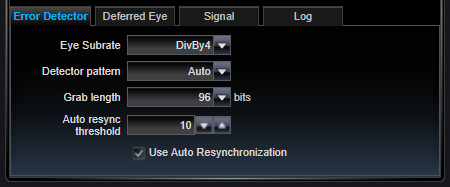Calibration Input - Error Detector
Provides error detector settings for configuring synchronization parameters and eye sub-rate. Eye sub-rate is use to determine what unit interval to associate with the eye diagram for use with the Eye Diagram Application.
|
Eye Subrate |
|
|
1X / 2X / 4X / 8X |
Set the anticipated sub-rate factor between the eye diagram to be measured and the data rate of the Pattern Generator. This is not to be confused the the Calibration Clocking sub-rate divider selection. For example, a test application at 16 Gbps which loops its full-speed signal into the Calibration Input has Error Detector eyes that match the data rate of the Pattern Generator, so the Eye Subrate would be 1X. This setting also depends on which type of sampler is being used. If a "DeferredEye" is being looked at but only a sub-rate of the deferred decisions are being forwarded to the Pattern Generator's Calibration input, this Eye Subrate must still be set to the eye diagram characteristics that we're going to draw. In this case, the deferred eye sees the full rate of the Pattern Generator and the Eye Subrate setting should, again, be 1X. If, in this same application, we changed from using the DeferredEye sampler (which is running at the full-rate) to the Calibration sampler (which is running at one-quarter of the full-rate), then the Eye Subrate setting would need to be changed to 4X. |
|
Detector Pattern |
|
|
Auto / AllZeroes / AllOnes / Grab / Prbs7 / Prbs11 / Prbs13 / Prbs15 / Prbs20 / Prbs23 / Prbs31 / InvPrbs7 / InvPrbs11 / InvPrbs13 / InvPrbs15 / InvPrbs20 / InvPrbs23 / InvPrbs31 / Unknown |
The built-in Calibration Input error detector supports all the same PRBS/All-Ones/All-Zeros patterns as the Pattern Generator. It also supports short repeating patterns (under 192 bits in length). Auto mode conveniently searches all pattern types and inversions of all pattern types for synchronization. |
|
Grab Length |
|
|
bits |
When using short repeating patterns, this setting defines the repeat boundary needed to gain synchronization. Patterns that repeat in this number of bits (as applied and sampled by the Calibration Input with the Calibration Clock divide ratio considered) will gain synchronization and will be able to be used for bit error rate measurements. Valid Grab Lengths are 32, 64, 96, 128, 160, 192 bits. |
|
Auto Resync Threshold |
|
|
|
Set the severity of the error which defines when a data stream is out of synchronization for error detection measurement. A high value would make it more difficult to drop out of synchronization. A low value might misinterpret a burst of errors as a synchronization loss. |
|
Use Auto Resynchronization |
|
|
On / Off |
Automatic resynchronization allows the Calibration Input error detector to automatically look for new synchronization when an old synchronization is lost. Data streams that have consecutive errors in "Auto Resync Threshold" number of 32-bit words are considered "out of sync" and would trigger a new attempt to gain synchronization. |
See Also
